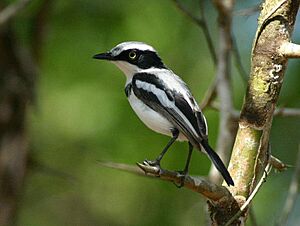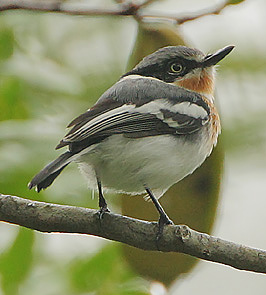Mozambique batis facts for kids
Quick facts for kids Pale batis |
|
|---|---|
 |
|
| male | |
 |
|
| female | |
| Conservation status | |
| Scientific classification |
The pale batis (Batis soror) is a small, active bird found in eastern Africa. It's also known as the Mozambique batis or East coast batis. This bird belongs to the wattle-eyes family, called Platysteiridae. You can usually find it in lowland miombo woodlands.
Contents
What Does the Pale Batis Look Like?
The pale batis is a striking bird with black, white, and grey colors. Its upper body is pale grey. It has a black mask on its face, outlined by a thin white stripe above its eye. Its eyes are yellow.
Its back is pale grey with faint white spots. The underside of the bird is white. Males have a clear black band across their chest. Females have a pale reddish-brown chest band and a similar colored spot on their chin.
Both their beak and legs are black. Young pale batis birds look similar to the females. However, their chest band is browner, and their underparts have a slightly yellowish-brown tint. This small bird is about 10.5–11.5 cm (4.1–4.5 in) long and weighs between 8–13.1 g (0.28–0.46 oz).
How Does the Pale Batis Sound?
The pale batis has a special call to mark its territory. It's a sad, long, and clear three-note sound: "pook pook pook." This call can be repeated up to 12 times at a steady pace.
When the male calls, the female often joins in with excited "wik-wik" sounds. Besides these calls, they also make typical batis sounds. These include snapping their bills, making soft "churr" noises, and whistling.
Where Do Pale Batis Birds Live?
The pale batis lives in eastern Africa. You can find them along the coast of Kenya, including the Arabuko Sokoke National Park. They also live south through eastern and south-eastern Tanzania.
They are found on the islands of Zanzibar and Mafia. Their range extends into Mozambique, reaching as far south as the Save River. Inland, they are found in south-eastern Malawi. They also live on the east-facing slopes of the Eastern Highlands in Zimbabwe.
What Kind of Places Do They Prefer?
The pale batis usually lives in lowland miombo woodlands. These are often found below 500 m (1,600 ft) in coastal areas. Here, you'll see a mix of forest and thick bushes.
Sometimes, they can also be found in mopane and acacia woodlands. These are usually at the edges of their main living areas. In the Eastern Highlands of Zimbabwe, they can live at higher altitudes, up to 1,500 m (4,900 ft) above sea level. Here, they prefer tall Uapaca kirkiana stands, thickets of Philippia species, and woodlands with mountain acacia.
What Are the Habits of the Pale Batis?
Scientists don't know much about what the pale batis eats. We do know that they catch insects from leaves and branches. Sometimes, they hover in the air to pick off insects. They often join groups of different bird species that are foraging together.
Their social behavior is likely similar to other batis birds. They are usually seen alone, in pairs, or in small family groups. However, before the breeding season, males might gather in groups. These groups are sometimes called "parliaments." They fly around excitedly, snapping their bills, flapping their wings, and making "wik" calls.
Pale Batis Reproduction and Nesting
During courtship, the male pale batis performs a zigzag flight display. He also flaps his wings, fans his tail, and fluffs up the long, white-spotted feathers on his rump. While doing this, he makes loud "week-week-week" calls. The female joins in with her own excited "wik-wik" call.
The nest of the pale batis is a small, deep cup. It's built from thin strips of Combretum bark and pieces of grass flowers. They hold the nest together using spider webs. The nest is usually placed in the fork of a tree branch. It's typically at least 6 m (20 ft) above the ground.
Females usually lay a small clutch of about one to two eggs. This happens between September and November. The female is responsible for incubating the eggs. She also does all the initial feeding of the young chicks. The male helps feed the chicks once they are older. They only defend the area immediately around their nest.


